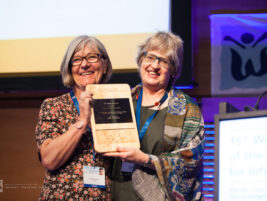I wish someone had shared ACEs research with me when I was a young parent. I didn’t know then what I know now (NEAR@Home, p. 10).
Parents have the right to know the most powerful determinant of their children’s future health. The most powerful people for reducing ACE scores in the next generation are parenting adults. Parents have the most opportunity and the most potential for changing the trajectory of the public’s health for generations. But parents must actually know about ACEs and their effects in order to realize this potential (NEAR@Home, p. 12).
Many early childhood and infant mental health professionals are familiar with Adverse Childhood Experiences (ACEs) and are able to adopt a trauma lens in their work with families. Even with this awareness, the effects of ACEs can feel overwhelming for the parent and early childhood home visitor, and many find themselves asking “what can I do about it?”
In 2013, home visiting professionals from the Pacific Northwest region of the United States gathered to address the question: How do we bring ACEs information to parents in a way that feels safe and supported? Systems leaders, home visitors, and tribal leadership from Alaska, Idaho, Oregon, and Washington worked together to develop what is now the NEAR@Home toolkit, a free downloadable guide for home visiting professionals to facilitate conversations around ACEs.
Grounded in principles of social justice, infant mental health, and trauma-informed care, the NEAR@Home toolkit aims to support hope and resilience through five core elements of Preparing, Asking, Listening, Affirming, and Remembering.
NEAR combines the latest science from:
-
- Neuroscience;
- Epigenetics;
- Adverse Childhood Experiences: and
- Resiliency.
When used in the context of the home visiting relationship, these elements set the foundation for families to be seen, heard, and felt as parents reflect on their ACEs and resilience and how they want their child’s life to be different.
In 2017 an in-person learning process was developed and refined through funding by the Region X MIECHV Innovation Grant. Over the past two years, five Infant Mental Health professionals were trained as NEAR@Home facilitators to support a total of 225 home visitors and 54 supervisors in learning the NEAR@Home process.
While learning NEAR@Home, early childhood teams are guided through reflective, relationship-based process in exploration of feelings and skills in discussing ACEs and NEAR science with parents of young children. Consideration for safety and wellbeing of home visitors is central to the NEAR@Home learning process: 81% of home visitors responding to a 2019 Region X Workforce Study reported a history at least 1 ACE, with 33% reporting 4 or more ACEs (Roberts, et al., 2019).
The work of NEAR@Home is deeply rooted in parallel process and facilitators work to create space for the home visitors and supervisor as they integrate their own experiences of being parented. Quality Reflective Supervision is central to the NEAR@Home process, as the home visitor and supervisor uncover their own stories in the process. For example, as part of the facilitated learning of NEAR, we ask that all home visitor’s and supervisors complete the ACE questionnaire on their own, to have the felt experience of what we are asking families to do, as well as to honor the parallel process.
Ideally, we hope that the program has quality and regular Reflective Supervision in place for home visitors and supervisors as we know home visitor’s in particular come to the work often with similar stories or themes as the families they serve. The facilitators do a great deal of attuning, containing, and holding space during the facilitated learning process as we honor what is activated (unspoken or spoken) when trauma is directly talked about in a supportive, respectful way.
Aligned with the funding focus, to date we have focused on the home visitor experience and those of their supervisors. Home visitors have shared the following responses to learning NEAR@Home:
Learning about NEAR@Home has helped me to be more curious about a parents’ experience early in their life and how those experiences might inadvertently be impacting the parenting relationship. It has also expanded my curiosity about other traumatic experiences such as historical trauma. It has changed the way I think about adversity (NEAR@Home, p. 15).
I thought it would be really difficult to think about what to do next. I’m remembering that sometimes the intervention is in being there. I thought I would need to have a lot of resources available but they’re not asking for that – they’re enjoying the awareness. The conversations that come afterward are what’s important. The people I’ve done it with have not needed therapy afterward. I haven’t had to figure out what to do next (p. 48).
For more information and to download the NEAR@Home toolkit, please see: www.nearathome.org.
For more information about the program: https://givingcompass.org/article/reducing-childhood-trauma-home-visiting/
Roberts, A., Wacker, A., Franko, M., Schaack, D., Molieri, A., Estrada, M., & Gann, H. (2019). The region X home visiting workforce study: The health and well-being of the region X home visiting workforce (Issue brief No. 4). Denver, CO: Butler Institute for Families, Graduate School of Social Work, University of Denver. Retrieved from https://www.dcyf.wa.gov/sites/default/files/pdf/RegXWorkforceStudyBrief4.pdf
NEAR@Home: Neuroscience, epigenetics, adverse childhood experiences, resilience: Addressing ACEs in home visiting by asking, listening, and accepting (3rd ed.). Seattle, WA: Thrive Washington. Retrieved from https://www.nearathome.org
Authors
Catherine Blair (USA), Rhonda Crooker (USA), Michelle Harvey (USA), Jeanine Jeffers-Woolf (USA), Leah Niezwaag (USA) and Carol Young (USA)








